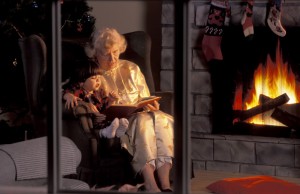A Christmas Story: 25 Years Later

Christmas time at the Parker home was always full of surprises. One of Ralph’s earliest memories of Christmas was the year he wanted only one thing for Christmas – a Red Ryder BB gun. He spent the weeks leading up to that Christmas morning trying to convince his parents to get him one, but his mother refused, fearing he would shoot his eye out.
On Christmas morning, after initially being disappointed when opening what he thought was his last present without coming across the BB gun, Ralph was surprised to find he had one more present to open that had been half hidden. Ralph could still remember the excitement he felt when he tore open the package to find the Red Ryder BB gun he wanted so badly.
Ironically, one of the first shots he took with his new BB gun ricocheted off a metal sign, hit him in the face, and broke his glasses. His mother had been right. The situation digressed in the aftermath of the fateful shot, and the Parkers ended up losing their Christmas dinner to a pack of hungry dogs from next door.
Despite all that happened that year, and despite anything that might have been going on in the lives of the Parkers during any Christmas season, they always made sure that Christmas was all about the three F’s – Fun, Food, and Family – with the emphasis on Family. Like any family, the Parkers had their ups and downs. Over the past 25 years, they had made it through much more serious problems than the BB gun incident. But this year, Ralph was trying to sort through a situation involving a fourth F that threatened to overwhelm the other three–Frustration.
Ralph’s Old Man had always run a tight ship. He controlled anything and everything that went on at the Parker house. Every decision he made might not have been perfect, but he was always in charge. But when Ralph came home for Christmas this year, things seemed to have changed.It was hard for Ralph to admit it, but his father’s health had significantly declined over the past year. Ralph’s father was easily confused, and things around the house just seemed out of order.
When Ralph found a minute alone with his mother to ask about his father, she confirmed that his father wasn’t doing well.
Ralph was concerned enough that he scheduled a meeting with an Elder Law attorney immediately after the holidays. He didn’t really know what he hoped to learn – his parents had already done an Estate Plan several years ago. They set up a living trust to avoid probate court and power of attorney documents to stay out of guardianship court. Ralph thought they had done essentially all they could do to plan for the future, but he wanted to be sure.
Ralph’s meeting with the Elder Law attorney turned out to be extremely enlightening. Ralph learned that there is a big difference between Estate Planning and Asset Protection Planning. The difference centers on the planning goals of the client.
In Estate Planning, a client can avoid the cost and hassle of probate by using a living trust and avoid guardianship by using power of attorney documents. A client can even protect the inheritance they plan to leave to their heirs from creditors. However, where Estate Planning often falls short is preparing for the potentially devastating costs of long-term care. The use of a living trust, which is very common in Estate Planning, offers no protection of assets if and when long-term care is needed.
The Elder Law attorney explained to Ralph that, considering his father’s declining condition, Asset Protection Planning was probably long overdue. When engaging in Asset Protection Planning, a client can do virtually everything he or she would want to do in a typical estate plan, like avoid probate court and protect their heirs. But clients can also meet other goals.
Particularly, clients can shelter their assets in such a way that they will be protected from the costs of long-term care if and when home caregivers, assisted living, or nursing home care are needed. Asset Protection Planning often involves the use of trusts, just like Estate Planning, but the details of the trusts are significantly different from living trusts in order to provide the Asset Protection clients are looking for. The attorney warned that for many types of Asset Protection Plans, a five year look back applies, so clients cannot wait until the need for long-term care arises to engage in planning.
Ralph agreed that Asset Protection Planning was long overdue, but he was thankful to have learned about it now instead of finding out there was more they could have done after long-term care expenses started mounting up.









0 comments